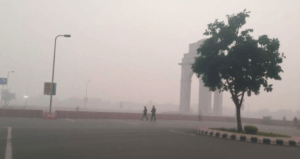Delhi Air Quality Improves: GRAP-I Restrictions Lifted After AQI Drops to 153 | Big Relief for NCR
Delhi-NCR has lifted the first stage of anti-pollution measures under GRAP-I after air quality improved significantly. The Commission for Air Quality Management (CAQM) made this decision as Delhi’s AQI dropped to 153, falling into the ‘moderate’ category. The improvement is largely due to weather changes, with strong winds helping disperse pollutants. Just days ago, the city saw temperatures soar to 40°C, but a sudden dip to 32°C improved conditions. The Indian Meteorological Department (IMD) predicts that while temperatures will remain lower for now, they may rise again soon.
Despite lifting restrictions, authorities emphasize continued pollution control, especially targeting dust from construction sites and roads. GRAP is a system that enforces stricter measures based on AQI levels, with Stage I triggered when air quality reaches the ‘poor’ category (201-300). Now that Delhi’s air quality has improved, restrictions have been eased, but efforts to curb pollution must continue.

Delhi Air Quality Improves: GRAP-I Restrictions Lifted After AQI Drops to 153 | Big Relief for NCR
Delhi-NCR has suspended the first phase of its anti-pollution measures under the Graded Response Action Plan (GRAP) following a visible improvement in air quality. The decision, announced by the Commission for Air Quality Management (CAQM), comes after Delhi’s Air Quality Index (AQI) dropped to 153 on a recent Saturday, placing it in the ‘moderate’ category. This marks a significant shift from earlier pollution levels, prompting authorities to ease restrictions while emphasizing the need for continued vigilance.
Weather Plays a Key Role in Clearing the Air
The improvement in air quality is largely attributed to favorable weather patterns. Over just two days, temperatures in the capital fluctuated dramatically—from a high of 40°C to a cooler 32°C by Friday. This sudden drop, coupled with strong surface winds, helped disperse pollutants that had accumulated in the atmosphere. According to the CAQM, these meteorological conditions were critical in reducing pollution levels. The Indian Meteorological Department (IMD) predicts that while temperatures are expected to stay below average for the next few days, a rise is likely in the coming week. However, current forecasts suggest the AQI will remain in the ‘moderate’ range (101–200), allowing authorities to temporarily roll back GRAP-I measures.
What Triggered the Change?
GRAP is a tiered system designed to combat air pollution in Delhi and its surrounding regions. It categorizes actions into four stages, each corresponding to specific AQI thresholds:
- Good (0–50)
- Satisfactory (51–100)
- Moderate (101–200)
- Poor (201–300)
- Very Poor (301–400)
Stage I (GRAP-I) is activated when the AQI enters the ‘Poor’ category (201–300). Under this phase, authorities implement measures such as halting non-essential construction work, enforcing traffic regulations to reduce vehicular emissions, and tightening controls on industrial pollution. With Delhi’s AQI now below 200, these restrictions have been lifted.
Why GRAP Matters
The Graded Response Action Plan was introduced to provide a structured approach to tackling Delhi’s chronic air pollution crisis. By linking actions to real-time AQI data, the system ensures swift responses to deteriorating air quality. For instance, GRAP-I’s construction bans aim to curb dust—a major pollutant in a region riddled with infrastructure projects. Similarly, traffic adjustments during this phase encourage the use of public transport and reduce congestion-related emissions.
Challenges Remain
While the temporary relief is welcome, the CAQM has cautioned against complacency. Dust from construction sites, roads, and open areas remains a persistent issue. Agencies have been directed to monitor compliance with pollution control guidelines rigorously. For example, construction sites must adhere to dust-management norms, such as covering debris and using water sprinklers. Likewise, municipal bodies are tasked with preventing garbage burning and ensuring frequent mechanical sweeping of roads.
Public Health Implications
Air quality in the ‘moderate’ category, while an improvement, still poses risks. Health experts note that prolonged exposure to even moderate pollution levels can affect vulnerable groups, including children, the elderly, and those with respiratory conditions. The lifting of GRAP-I does not eliminate these risks but reflects a short-term reduction in emission sources.
Looking Ahead
The IMD’s warning of rising temperatures underscores the fragile nature of these gains. Warmer weather can increase ozone formation and trap pollutants closer to the ground, potentially pushing the AQI back into the ‘Poor’ category. Authorities are thus urging residents to stay informed and adopt preventive measures, such as minimizing outdoor activities during peak pollution hours and using masks in crowded areas.
A Collective Effort
The CAQM’s decision highlights the importance of adaptive strategies in pollution control. While natural factors like wind and temperature play a role, sustained improvement requires year-round efforts. Initiatives like transitioning to electric public transport, promoting green energy, and expanding green spaces are long-term solutions that complement GRAP’s emergency measures.
In Summary
Delhi-NCR’s air quality improvement offers a breather, but the battle against pollution is far from over. The suspension of GRAP-I reflects the effectiveness of immediate actions and favorable weather, yet it also serves as a reminder of the region’s vulnerability to environmental shifts. As temperatures fluctuate, coordinated efforts between government agencies, industries, and citizens will remain crucial to ensuring cleaner air for all.
By staying proactive and adhering to pollution control protocols, Delhi can aim for longer periods of ‘moderate’ or even ‘satisfactory’ air quality—a goal that demands persistence, innovation, and public participation.
You must be logged in to post a comment.